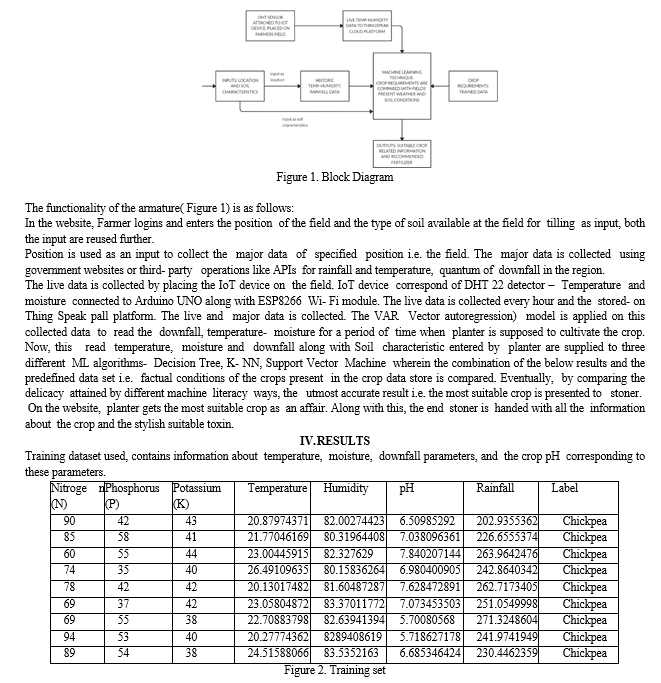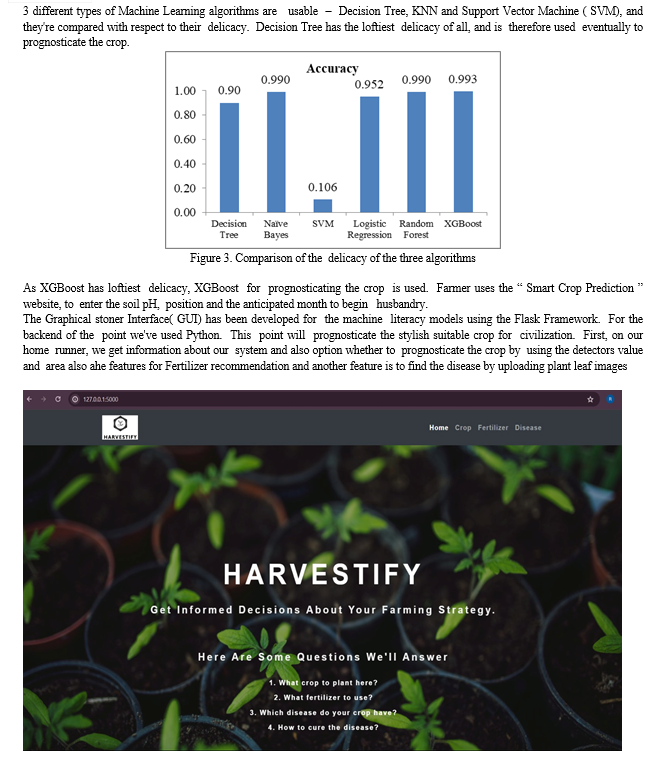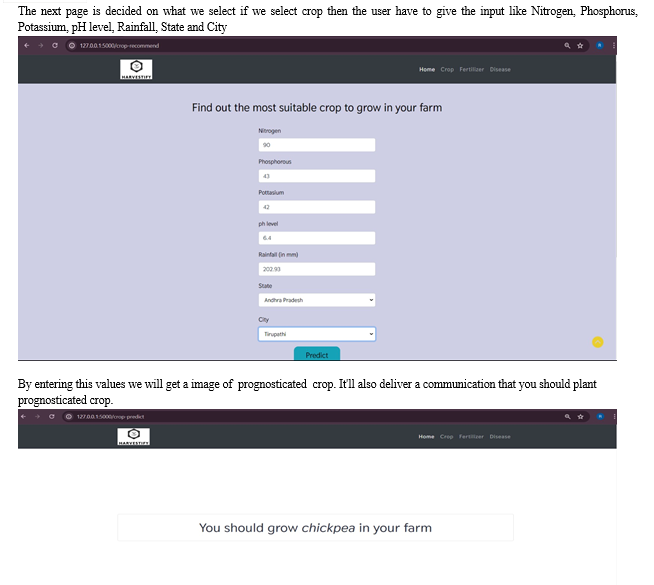Ijraset Journal For Research in Applied Science and Engineering Technology
- Home / Ijraset
- On This Page
- Abstract
- Introduction
- Conclusion
- References
- Copyright
Smart Crop Prediction using IoT and Machine Learning
Authors: Prof. A. A. Chaudhari, Rishi Vyas, Shivam Supekar, Kartik Dhole, Darshana Gujare, Rushikesh Chandekar
DOI Link: https://doi.org/10.22214/ijraset.2024.60653
Certificate: View Certificate
Abstract
Agriculture is a crucial profitable motorist. It\'s a key to healthy biosphere. People depend on a wide range of agrarian products in nearly all aspects of life. growers need to manage with climate change, and meet rising demands for further food of advanced food quality. In order to escalate the yield and growth of crops, the planter needs to be apprehensive of the climatic conditions, hence abetting its decision of growing the suitable crop, under those factors. IoT grounded Smart Farming improves the entire husbandry system by covering the field in real- time. It keeps colorful factors like moisture, temperature, soiletc. under check and gives a crystalclear real- time observation. Machine literacy in husbandry is used to ameliorate the productivity and quality of the crops in the husbandry sector. Use of applicable algorithms on the tasted data can help in recommendation of suitable crop.
Introduction
I. INTRODUCTION
Agriculture plays a vital part in the Indian frugality. Over 70 of the pastoral homes depend on husbandry. Agriculture is an important sector of Indian frugality as it contributes about 17 to the total GDP and provides employment to over 60 of the population. Indian husbandry has registered emotional growth over last many decades. still, growers ’ self-murders in India is fussing. The unexpressed reasons in order of significance behind planter suicides were – debt, terrain, low yield prices, poor irrigation, increased cost of civilization, use of chemical diseases and crop failure. A planter’s decision about which crop to grow is generally clouded by his suspicion and other inapplicable factors like making instant gains, lack of mindfulness about request demand, overvaluing a soil’s eventuality to support a particular crop and so on. The need of the hour is to design a system that could give prophetic perceptivity to the Indian growers, thereby helping them make an informed decision about which crop to grow. This calls for the need of smart husbandry, which requires use of IoT. operation of IoT in husbandry could be a life changer for humanity and the whole earth. Detector data analytics drives translucency into agrarian processes, as growers get precious perceptivity on the performance of their fields, glasshouses, etc. tilling powered by Machine Learning with its high- perfection algorithms is a new conception arising moment. Aiming to increase the volume and quality of products, this slice- edge movement makes sustainable productivity growth for everyone working in the husbandry realm. With this in mind, we propose system for Smart operation of Crop civilization using IoT and Machine literacy – a smart system that can help growers in crop operation by considering tasted parameters( temperature, moisture) and other parameters( soil type, position of ranch, downfall) that predicts the most suitable crop to grow in that terrain.
II. LITERATURE REVIEW
As per Climate Change Crop Yield hypotheticals report in [9], Crop Yields are projected to decline, with the larger declines to be anticipated in several developing husbandry which includes Southeast Asia(- 5 percent) and India(- 5 percent). [10] The variation in on- ranch losses across regions may be incompletely explained by the range of reasons which include structure and marketing challenges, infelicitous crop timing, unanticipated harsh climatic conditions and unfit to prognosticate suitable crops for husbandry in similar climates. The following comparison is show below
Rushika Ghadge, Juilee Kulkarni, Pooja More, Sachee Nene, Priya R L in [1] uses unsupervised and supervised literacy algorithms like Kohonen Self Organizing Map and Back Propagation Network. Dataset is trained by learning networks to classify it into organic, inorganic and real estate for prognosticating the type of soil. It compares the delicacy attained by different network literacy ways and the most accurate result is delivered to the end stoner. System will check soil quality and prognosticate the crop yield consequently along with it give toxin recommendation if demanded depending upon the quality of soil.
Reference Paper [2] determines real time slice of soil parcels using MODIFIED SUPPORT VECTOR REGRESSION, a popular machine learning algorithm and four modules. The Modules include Sensor connived to IoT device, Agri cloud, assaying the real time detector data and Agri stoner interface( AUI). The first module is movable IoT device NodeMCU) with soil humidity detector and pH detector, environmental detectors. Agri cloud module consists of storehouse. assaying the real time data module is processing of types of crops and small shops suggested using modified support vector machine algorithm. Agri- stoner interface is a introductory web interface. therefore, with the help of soil parcels planter will be suitable to get types of crops and small shops is grown in cropland with help of Modified support vector machine algorithm. 18 International Journal of Engineering Research & Technology( IJERT) ISSN 2278- 0181 Published by,www.ijert.org NTASU- 2020 Conference Proceedings Volume 9, Issue 3 Special Issue- 2021
[3] predicts temperature, humidity and pH value for crop vaticination using the ARIMA model. The model takes the values from database as input and also predicts what will be the value of that particular parameter after 1 month. The prognosticated values are also transferred to K means algorithm for bracket grounded on pH value therefore creating k clusters of crops having analogous pH value. KNN algorithm is used to prognosticate top N suitable crops which are displayed to stoner.
In [4], Machine Learning Algorithm( KNN) calculates the parameter to suggest the crop which is stylish to grow in the particular field grounded on the values entered at real time. A standardized dataset containing the minimal conditions for a particular crop is maintained and is used for the vaticination of the crop. The detectors are added to the field for which the readings are demanded to be calculated. The DHT11, MQ2, Soil humidity Sensor, Light Intensity Sensor sends the readings in real time to the pall garçon.
[5] evaluates the crop quality factor grounded onpre-established rainfall conditions and nature of soil using the trained set of data and enforcing Supervised and underpinning models of machine literacy. If any inimical conditions are perceived ahead of time, the volition and precautious measures are espoused so as to insure the good of the planted crops and agrarian land. Specific measures are also taken to prognosticate the right period of sowing, reaping and harvesting for the overall improvement of the product which can also be previsioned as a part of the ultramodern agrarian revolution.
|
Citat ion |
Major Algorithm Implemented |
Information Conceived |
|
[1] |
Kohonen Self Organizing Map and Back Propagation Network |
|
|
[2] |
Modified Support Vector Regression |
|
|
[3] |
K-nearest neighbors (KNN) algorithm |
|
|
[4] |
ARIMA model |
|
|
[5] |
Reinforcement models like Markov Decision Process and Q learning |
|
III. PROPOSED SYSTEM
The system aims to help growers for smart decision while prognosticating the crops. To increase the delicacy along with live data, major data for temperature and moisture from government website is also collected and stored. Also major downfall data is collected and stored. To be definite and accurate in crop vaticination, the design analyzes the temperature and moisture of the field – live data collected using DHT- 22 detector and major data collected from government website and/ or google rainfall API, type of the soil – used by the planter and the major downfall data. It can be achieved using unsupervised or supervised machine literacy algorithm. By learning networks, dataset is trained. The delicacy attained by different machine literacy ways are compared to get the most accurate result which in turn will be delivered to the end stoner. Along with the most suitable crop, the system also recommends the toxin for that crop. Responsive, Multilingual website is used by planter to communicate with the system.
A. Hardware Components
Digital Temperature & moisture Detector DHT22 detector is preferred to cover live temperature and moisture. This detector is proved to be more precise and accurate. It uses a capacitive moisture detector and a thermistor to measure the girding air, and spits out a digital signal on the data leg to Arduino Uno harborage leg. The range of DHT22 is 0 to- 100 RH for moisture and - 40 to 80 degree Celsius for temperature.



Conclusion
In this paper, we\'ve proposed an innovative and comprehensive approach to smart husbandry that harnesses the important capabilities of two slice- edge technologies the Internet of effects( IoT) and Machine literacy( ML). By seamlessly integrating these two arising fields, our proposed system aims to revise the agrarian sector, empowering growers with unknown perceptivity and decision- support tools. The synergistic combination of live data aqueducts from IoT detectors and literal data depositories enables our system to achieve unequaled situations of delicacy in its prognostications and recommendations. By continuously covering real- time environmental conditions, soil humidity situations, rainfall patterns, and other pivotal factors, the IoT element provides a constant sluice of over- to- date information. contemporaneously, the integration of literal data allows our ML algorithms to identify patterns, trends, and correlations that may not be incontinently apparent, farther enhancing the system\'s prophetic capabilities. Likewise, our approach leverages the power of multiple ML algorithms, each with its unique strengths and specializations. By employing an ensemble of algorithms and using their reciprocal capabilities, our system can give further robust and accurate analyses, counting for the essential complications and variabilities present in agrarian disciplines. The ultimate thing of our proposed result is to palliate the challenges faced by growers and contribute to the sustainable growth and productivity of the agrarian sector. By furnishing data- driven perceptivity, optimized resource allocation strategies, and timely cautions for implicit pitfalls or openings, our system empowers growers to make informed opinions, maximize yields, and minimize destruction. also, our approach has the implicit to enhance the quality of agrarian yield, icing that crops are cultivated under optimal conditions and clinging to strict quality norms. This not only benefits growers economically but also contributes to food security and promotes environmentally sustainable practices. In summary, our innovative approach to smart husbandry, driven by the community of IoT and ML technologies, represents a significant stride towards a more effective, productive, and sustainable agrarian future. By employing the power of data, analytics, and slice- edge technologies, we aim to revise the way husbandry is rehearsed, fostering a paradigm shift that benefits growers, consumers, and the terrain likewise.
References
[1] Rushika Ghadge, Juilee Kulkarni, Pooja More, Sachee Nene, Priya R L, “Prediction of Crop Yield using Machine Learning,” International Research Journal of Engineering and Technology (IRJET) Feb 2018, pp. 2237-2239 [2] Radhika, Narendiran, “Kind of Crops and Small Plants Prediction using IoT with Machine Learning,” International Journal of Computer & Mathematical Sciences April 2018, pp. 93-97 [3] Shridhar Mhaiskar, Chinmay Patil, Piyush Wadhai, Aniket Patil, Vaishali Deshmukh, “A Survey on Predicting Suitable Crops for Cultivation Using IoT,” International Journal of Innovative Research in Computer and Communication Engineering January 2017, pp. 318-323 [4] T Raghav Kumar, Bhagavatula Aiswarya, Aashish Suresh, Drishti Jain, Natesh Balaji, Varshini Sankaran, “Smart Management of Crop Cultivation using IOT and Machine Learning,” International Research Journal of Engineering and Technology (IRJET) Nov 2018, pp. 845-850 [5] Akash Raj N, Balaji Srinivasan, Deepit Abhishek D, Sarath Jeyavanth J, Vinith Kannan A, “IoT based Agro Automation System using Machine Learning Algorithms”, International Journal of Innovative Research in Science, Engineering and Technology November 2016, pp.19938-19342 [6] Food and Agricultural Organization. (2018). The state of Agricultural Commodity Markets. 19-22. [7] Food and Agricultural Organization. (2019). The state of Food and Agriculture. 23-27.
Copyright
Copyright © 2024 Prof. A. A. Chaudhari, Rishi Vyas, Shivam Supekar, Kartik Dhole, Darshana Gujare, Rushikesh Chandekar. This is an open access article distributed under the Creative Commons Attribution License, which permits unrestricted use, distribution, and reproduction in any medium, provided the original work is properly cited.

Download Paper
Paper Id : IJRASET60653
Publish Date : 2024-04-20
ISSN : 2321-9653
Publisher Name : IJRASET
DOI Link : Click Here
 Submit Paper Online
Submit Paper Online

